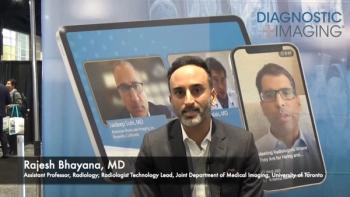
What a New Study Reveals About MRI-Guided Use Of Contrast-Enhanced Mammography
Researchers found the combination of magnetic resonance imaging (MRI) and contrast-enhanced mammography was nearly 22 percent more effective at detecting breast lesions than MRI-directed ultrasound.
For biopsy planning of suspicious findings from breast magnetic resonance imaging (MRI), emerging research suggests that contrast-enhanced mammography (CEM) may be more advantageous than ultrasound.
In a new retrospective study published in the
The study authors found that MRI-directed CEM had a 69.7 percent rate (76/109) of detecting breast lesions in comparison to a 45.9 percent detection rate (50/109) for MRI-directed ultrasound. The combined use of MRI-directed CEM and ultrasound had a 77.1 percent detection rate (84/109).
“Among lesions evaluated by combined MRI-directed CEM and ultrasound, the lesion detection rate was significantly higher for MRI-directed CEM than for MRI-directed ultrasound,” wrote study co-author Matthew M. Miller, M.D., Ph.D., an assistant professor at the University of Virginia, and colleagues.
However, the authors noted that the detection rate for malignant breast lesions was not significantly different between MRI-guided CEM and MRI-guided ultrasound. Miller and colleagues suggested the small number of malignancies (21/109) in the study may have factored into this finding. They emphasized that MRI-directed ultrasound exclusively detected only 7.3 percent of all lesions and did not detect any malignancies. In comparison, the researchers noted that 31.2 percent of the overall lesions and 17.4 percent of malignant lesions were only seen on MRI-directed CEM.
“MRI-directed CEM may be a useful alternate or complementary tool to MRI-directed ultrasound for biopsy planning, facilitating biopsy guidance methods other than MRI guidance,” suggested Miller and colleagues.
In addition to the single-site retrospective design, the study authors said another limitation of the study was only including patients who were recommended for MRI-directed CEM as this may have led to a higher percentage of lesions more likely to be evident on CEM. Miller and colleagues also noted that clustering effects of multiple lesions for individual patients was not considered in the study analysis.
Newsletter
Stay at the forefront of radiology with the Diagnostic Imaging newsletter, delivering the latest news, clinical insights, and imaging advancements for today’s radiologists.




























